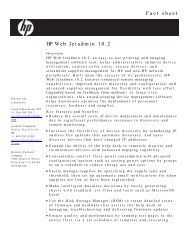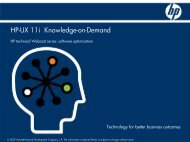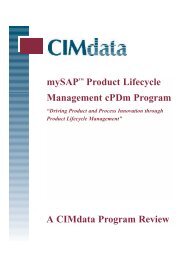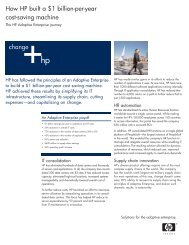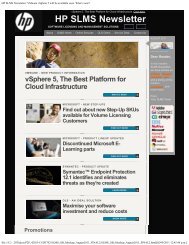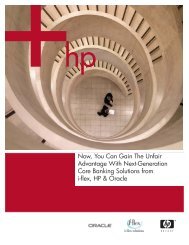Adaptive Product Lifecycle Management - Large Enterprise ...
Adaptive Product Lifecycle Management - Large Enterprise ...
Adaptive Product Lifecycle Management - Large Enterprise ...
Create successful ePaper yourself
Turn your PDF publications into a flip-book with our unique Google optimized e-Paper software.
<strong>Adaptive</strong> <strong>Product</strong> <strong>Lifecycle</strong> <strong>Management</strong><br />
The story, success, and vision of the HP/Compaq merger<br />
Executive summary............1<br />
The goal ..........................2<br />
The plan ..........................5<br />
The value .........................7
Executive summary<br />
In companies around the world, executives are seeking<br />
fresh management approaches that facilitate positive<br />
change and support innovation. In the current economic<br />
environment, it’s no longer enough to merely cut costs or<br />
boost efficiencies. Today’s successful companies – from<br />
established organizations accommodating changing<br />
business conditions to newly merged corporations<br />
seeking maximum synergies – need a visionary<br />
approach. They need a strategy that not only addresses<br />
the market demand for enhanced customer satisfaction,<br />
but also prepares business leaders to quickly seize new<br />
opportunities. For many corporations, carefully evaluating<br />
the organization’s product lifecycle management/<br />
collaboration (PLM/PLC) processes and environment is<br />
a way to achieve this.
By creating a strategy for success within its<br />
own product lifecycle environment, HP<br />
overcame many obstacles and made a few<br />
technology breakthroughs. As a result,<br />
HP is uniquely positioned to share these<br />
experiences with other large manufacturing<br />
companies facing similar issues, whether<br />
they are engaged in mergers or acquisitions,<br />
or simply embracing new business models.<br />
A well-designed, well-executed PLM strategy can provide<br />
tremendous value to a company. PLM can connect major<br />
corporate stakeholders into an integrated environment<br />
that enhances the creation of innovative products and<br />
services; it supports collaborative relationships within<br />
and outside the company; and it delivers cost reductions,<br />
quality improvements, and shorter time to market.<br />
Carefully planned and executed, PLM can be a catalyst<br />
for positive business change.<br />
Understanding this potential for value creation, the<br />
executive teams of pre-merger Hewlett-Packard Company<br />
and pre-merger Compaq Computer Corporation<br />
focused on PLM to help create maximum synergies<br />
from the merger of the two companies – synergies<br />
that would capture the best of each organization and<br />
lay the foundation for an innovative, forward-thinking<br />
new company.<br />
More than a year has passed since the HP/Compaq<br />
merger, and a refined PLM strategy is already beginning<br />
to deliver quantifiable results. This paper discusses the<br />
business challenges of merging two PLM strategies, the<br />
roadmap created to deliver on the PLM vision, and the<br />
value that PLM is delivering to HP. It also discusses how<br />
the merger and post-merger PLM expertise developed by<br />
HP can be applied to address the business challenges<br />
faced by many corporations today.<br />
The goal: Merging two global giants<br />
into one market leader<br />
Nearly every corporate merger is marked by difficult<br />
challenges and hidden pitfalls. But when the players<br />
include two global technology giants, the bar is much<br />
higher. The unprecedented merger of Hewlett-Packard<br />
Company and Compaq Computer Corporation in 2002<br />
was the largest of its kind – and not everyone was<br />
convinced that it would succeed. Unifying these corporate<br />
titans into a single, harmonious enterprise meant blending<br />
tens of thousands of products, customers, and global<br />
supply chain points involving over 100,000 suppliers into<br />
one organization – without sacrificing the customer-centric<br />
approach that defined them both.<br />
From the start, the management teams of both companies<br />
recognized the importance and need for an adaptive<br />
product lifecycle management (PLM) environment. Applied<br />
globally, this strategy would allow the new company to<br />
create consistent business roadmaps for products and<br />
services, effectively meeting the needs of its customer<br />
base and positioning the enterprise to rapidly seize new<br />
market opportunities. From this industry perspective, the<br />
importance of an adaptive PLM approach was not just<br />
fundamental to the overall merger strategy, but it was also<br />
essential to the ongoing success of the new company.<br />
2
Challenges<br />
Integration of two huge companies with massive, highly complex, global product lines<br />
• Approximately 200,000 products<br />
• <strong>Product</strong> refresh cycles for:<br />
– Printers of 3 to 7 months<br />
– PCs of 4 to 7 months<br />
– Workstations of less than 12 months<br />
– Supercomputers of 36 months or less<br />
• 100,000+ suppliers<br />
• More than 60% outsourced manufacturing<br />
• 60% collaborative design content<br />
Need for consistent, accurate product lifecycle data<br />
• Suitable to manage multi-billion dollar business<br />
• Extracted from multiple, highly diverse, legacy systems across multiple business units<br />
Needed strategy to quickly reduce complex infrastructure and high support costs<br />
“<strong>Large</strong> manufacturing<br />
companies face<br />
product data management<br />
problems<br />
and HP and<br />
Compaq were no<br />
exception. The<br />
merger gave us<br />
greater impetus to<br />
solve them. We are<br />
executing now as<br />
one company.”<br />
— David Savage,<br />
Manager, Global<br />
Operations IT, Master<br />
Data Group, HP<br />
The challenge: Complexity multiplied<br />
On the surface, it may have appeared that HP and<br />
Compaq were highly similar. After all, both manufactured<br />
personal computers, high-end servers, printers, storage,<br />
and other accessories. Yet there were marked differences<br />
in the way each company manufactured, marketed,<br />
sold, and serviced its products. To succeed, the new<br />
company had to blend these business units and<br />
eliminate redundancies, while continuing to deliver<br />
superior quality products and services to meet customer<br />
needs at competitive prices.<br />
Solutions<br />
To do this, the newly merged company needed to<br />
coalesce numerous independent, autonomous business<br />
units, with varying product charters. These structures were<br />
developed in the original companies to enhance financial<br />
and operational accountability; over time, however, they<br />
created complex relationships between business units<br />
and among divisions, contract manufacturers, and<br />
distributors. These structures hampered collaboration<br />
and communication as well as the ability to take<br />
advantage of efficiencies that standardization and sharing<br />
of data and information could create. From every aspect,<br />
the complexity of the merger challenge was extreme.<br />
• Senior management support – Master Data Council<br />
• Combined and redesigned PLM strategy initiated through “clean<br />
room” and an “adopt-and-go” philosophy<br />
• Standardization to create greatest efficiencies<br />
• Easy adaptability to recognize the unique needs of individual<br />
business units or geographies<br />
• One master data instance as a target, achievable through<br />
continued deployment of mySAP PLM<br />
The approach: From clean room to board room<br />
To address these challenges, the executive leadership<br />
team created “clean rooms” for each of the operating<br />
components of the two companies. These virtual work<br />
areas were staffed by employees from each company –<br />
domain-specific experts charged with developing<br />
strategies and plans, choosing tools, and outlining the<br />
execution of those plans throughout the merger and<br />
beyond. Supporting these teams was an “adopt-and-go”<br />
philosophy that fast-tracked the approval and<br />
implementation process for new approaches, as<br />
well as a Master Data Council that helped to<br />
streamline any changes.<br />
One of the clean room teams was assigned responsibility<br />
for formulating a merged PLM strategy. PLM clean room<br />
team members were selected in equal proportion from<br />
their expertise domains within each of the companies –<br />
bringing together the finest talent, best-in-class practices,<br />
critical experience, and recognized histories of the two<br />
organizations. “When you assess or review a product<br />
lifecycle environment, you must rethink the traditional<br />
structure of both the business and IT operations through<br />
the view of a new business model, and this can be<br />
very challenging,” says Cynthia Boresch, Director of<br />
Information <strong>Management</strong> for HP. “The representation<br />
in the clean room gave us a great opportunity to<br />
streamline and expedite this approach.”<br />
3
“The technology<br />
wars of the future<br />
are going to be<br />
won in engineering<br />
and design. Our<br />
PLM strategy will put<br />
HP in position to<br />
win that battle.”<br />
— Craig Flower,<br />
Group Information<br />
Officer, Global<br />
Operations IT<br />
The vision: Collaboration as a catalyst<br />
The PLM team began by outlining its vision for an effective<br />
product lifecycle environment – one that would adapt and<br />
respond to business needs quickly and allow HP to:<br />
• Design and build anywhere<br />
• Realize real-time collaboration across the<br />
virtual enterprise<br />
• Retrieve product information quickly and easily<br />
• Leverage business knowledge internally throughout<br />
the product lifecycle<br />
• Link the product development and lifecycle<br />
management process to the supply chain<br />
• Reduce the time needed to develop new products<br />
The PLM team then considered the business challenges<br />
that could impede the success of the PLM initiative. The<br />
team realized that the merged PLM strategy would require<br />
a modified business that would support the effective<br />
management of collaborative data across engineering,<br />
procurement, production, marketing, sales, and services.<br />
Effective data management would play a key role.<br />
The team knew there would be several obstacles to this<br />
objective, including:<br />
• Inconsistently defined responsibilities for data ownership<br />
• Inadequate product data integrity<br />
• Multiple processes being used by multiple business units<br />
• A need for a new point of view; not just getting<br />
product out – but drawing existing customers back<br />
and new customers in<br />
Thus, the PLM team determined that a critical and<br />
immediate need for the new company was to organize<br />
and define responsibilities and conditions for data<br />
ownership and management across the enterprise.<br />
In addition, the execution of the PLM strategy<br />
demanded an effective, integrated IT environment.<br />
Creating this required:<br />
• Elimination or minimization of numerous disparate,<br />
non-integrated IT systems within both companies<br />
that were creating roadblocks to data consistency,<br />
integration, and availability<br />
• Simplification of the IT infrastructure, which was<br />
complex, fragmented, and costly<br />
With these goals and challenges in mind, the PLM team<br />
designed a plan for transformation.<br />
4
The review process revealed that<br />
the two organizations handled<br />
product variations differently.<br />
Compaq employed a stock-keeping<br />
unit (SKU) based system, with each<br />
variation of a product assigned a<br />
unique SKU number. To order a<br />
product with specific features,<br />
customers used a specific SKU<br />
number. In contrast, HP customers<br />
entered a base model number and<br />
then specified associated feature<br />
kits. For new products, the team<br />
selected the base model approach<br />
to avoid the proliferation of SKU<br />
numbers, a problem Compaq had<br />
faced, and because the base<br />
model approach would more<br />
optimally meet the product lifecycle<br />
management business objectives.<br />
The PLM solution had to be able to<br />
address both product formats until<br />
the change-over to the base model<br />
approach could be completed.<br />
Internet-enabled <strong>Product</strong> <strong>Lifecycle</strong> <strong>Management</strong><br />
Distributors<br />
Customers<br />
Internet<br />
<strong>Product</strong><br />
<strong>Lifecycle</strong><br />
<strong>Management</strong><br />
People<br />
Process<br />
Systems<br />
Data<br />
Global<br />
business<br />
units<br />
Alliance<br />
partners<br />
The plan: Designing a product<br />
lifecycle roadmap<br />
Suppliers<br />
From the beginning, it was clear that the new company<br />
would implement the PLM strategy horizontally, across the<br />
global enterprise, so that it created efficiencies throughout<br />
all business units and delivered universal value. Defining<br />
this approach led the PLM team to evaluate the product<br />
lifecycle roadmap from several business process<br />
considerations, including:<br />
• Commonality: Where did both pre-merger companies<br />
have the same or similar processes in place to perform<br />
similar tasks?<br />
• Differences: Where did each organization take<br />
different approaches to perform similar tasks?<br />
What are these approaches?<br />
• Uniqueness: Where did each company perform tasks<br />
that were not addressed by the other organization?<br />
What are those tasks?<br />
• Best practices: Which practices work better for each<br />
business task?<br />
• Best-in-class: Would each practice play and integrate in<br />
a best-in-class product lifecycle environment?<br />
With this review complete, the team focused more<br />
extensively on three areas: commonality, differences, and<br />
product data management.<br />
Commonality: Develop and apply standards<br />
To optimize commonality across the new enterprise and<br />
support collaborative networks of global HP employees,<br />
customers, and suppliers, the PLM team and the Master<br />
Data Council determined that it was crucial to reduce the<br />
number of repositories for product data and to integrate<br />
or eliminate certain IT systems. In addition, the team<br />
recognized that, in some cases, standards needed to be<br />
developed and applied if the new company were to<br />
leverage consistency, streamline the integration efforts,<br />
and reduce the extreme complexity across the enterprise.<br />
This was a lofty goal. Few companies, especially those<br />
with highly distributed operations like HP, use a single<br />
set of design data formats, approvals, and processes<br />
for collaborating across their internal design teams, let<br />
alone for standardizing across their global enterprise<br />
of operation. But with the aspiration of creating one<br />
central data instance, HP raised the bar for building<br />
a business in which product definition information<br />
traversed organizational and geographical boundaries.<br />
Differences: Recognize unique needs<br />
Despite the desire to achieve commonality wherever<br />
possible, the PLM team also recognized that a “one-sizefits-all”<br />
plan is unrealistic. Each of the global business<br />
units within HP – including the Personal Systems Group,<br />
<strong>Enterprise</strong> Systems Group, Imaging and Printing Group,<br />
and HP Services – had different business drivers,<br />
including target markets, number of products, and<br />
product complexity.<br />
The PLM environment also had to manage the unique<br />
business requirements of the different sales regions.<br />
From including the appropriate power cord, to far<br />
more complex configuration issues mandated by local<br />
regulatory agencies, the PLM environment needed to<br />
allow flexibility and integration at key points throughout<br />
the many business unit value chains.<br />
In addition, the PLM solution had to support a variety<br />
of product generation applications used by different<br />
businesses, including legacy systems that would not<br />
immediately migrate to the new PLM solution. For<br />
example, the Imaging and Printing Group wanted to<br />
preserve its successful investment in PTC’s Windchill<br />
solution, because this technology worked well for their<br />
business unit’s manufacturing and collaboration model.<br />
5
One group of HP<br />
users estimates that<br />
the PDM initiative<br />
has reduced their<br />
setup time for<br />
parts by 94%,<br />
an excellent return<br />
on investment.<br />
The roadmap cornerstone: <strong>Product</strong> Data <strong>Management</strong><br />
Having defined the obstacles to effective data<br />
management and the need to adapt to unique business<br />
requirements, the PLM team then determined that a<br />
cornerstone of the product lifecycle management<br />
roadmap had to be a global product data management<br />
(PDM) initiative. PDM would address commonality,<br />
standardization, and unique integration needs that<br />
would not only reduce complexity but also create<br />
consistency and efficiencies across HP business units<br />
and their operations.<br />
Therefore, one key decision in the PDM initiative was to<br />
implement a single data management repository; this<br />
repository would serve as a central resource for critical<br />
corporate data, but it would be accessible to legacy<br />
applications at business units around the world. Using<br />
this approach, the PDM initiative would standardize the<br />
data, but continue to support the individual business<br />
needs of different regions, divisions, and business units.<br />
By structuring the PDM approach this way, the team<br />
could leverage the existing investments made by the<br />
two pre-merger organizations while paving the way for<br />
ongoing efficiencies and savings.<br />
The foundation of the PDM approach was based on<br />
mySAP <strong>Product</strong> <strong>Lifecycle</strong> <strong>Management</strong> (mySAP PLM).<br />
mySAP PLM was implemented to serve as the repository<br />
for HP product data. mySAP PLM is a collaborative design<br />
and engineering solution that can handle changes to<br />
the structure of existing products, new products, service,<br />
delivery, and repair on a global scale. The solution allows<br />
concurrent, collaborative activities across real-time points<br />
in the product lifecycle environment, and helps increase<br />
HP’s profitability requirements and satisfy customer and<br />
supplier interaction and expectations.<br />
SAP was not new to either HP or Compaq. In several<br />
business divisions, both companies had already invested<br />
significantly in SAP ® solutions, both in terms of license<br />
dollars and deployment value. HP and SAP have a long<br />
history of joint development. For example, many of the<br />
software upgrades to SAP applications for the high tech<br />
industry have been based on feedback from HP. “HP and<br />
SAP enjoy an exceptionally strong partnership,” says Eric<br />
Harper, Director of SAP Center for Expertise, Information<br />
Technology Office, Hewlett-Packard. “This benefits our<br />
customers through joint development of industry-specific<br />
offerings, which can then help solve the problems that<br />
many other global manufacturing companies face today.”<br />
The implementation of mySAP PLM to support the PDM<br />
initiative was well-received throughout the enterprise.<br />
“Using this technology is helping us consolidate<br />
engineering data into one collaborative environment,”<br />
explains Don Borgal, Director, Global Operations IT,<br />
Master Data Group HP. “mySAP PLM will have<br />
a huge impact on our bills of material, change<br />
management, and product design – saving millions<br />
of dollars across the organization. And it will support<br />
many of our goals, including being able to design and<br />
build products anywhere.”<br />
With the merger of HP and Compaq still in the early<br />
stages, it is clear that the PDM approach – based on<br />
mySAP PLM – is helping the going-forward company<br />
to unify product and service offerings and streamline<br />
business processes. As the company continues to evolve,<br />
HP will use mySAP PLM to tightly couple design and<br />
engineering, which will help HP serve its customers with<br />
unprecedented responsiveness. Looking forward, the<br />
adaptive PDM approach will allow all divisions within<br />
HP the interoperability to create and support the unique<br />
solutions they need to satisfy customer demand.<br />
6
Business benefits enabled by<br />
HP’s <strong>Product</strong> <strong>Lifecycle</strong> <strong>Management</strong><br />
environment include:<br />
• Faster time-to-market<br />
• More productive sales force<br />
• More efficient service and support<br />
• Elimination of duplicate parts<br />
• Coordination of new product<br />
introduction and product<br />
discontinuation<br />
• Market pricing of components<br />
• Opportunity for IT system<br />
consolidation<br />
• Consistency of interaction with<br />
customers and partners (service,<br />
ordering, parts, delivery, repair)<br />
The value: Dynamic<br />
business advantage<br />
With the core PLM strategy defined, and the merger just<br />
over one year old, the benefits provided by the adaptive<br />
PLM strategy are becoming clear. For HP’s customers,<br />
suppliers, contract manufacturers, and stakeholders,<br />
PLM is paving the way for new efficiencies – such as<br />
cost savings through decreased IT systems costs and<br />
reduced inventory exposure, as well as enhanced<br />
visibility across business units and regions for faster<br />
market responsiveness. The sections that follow describe<br />
the explicit benefits delivered by or expected soon from<br />
the PLM solution.<br />
Key benefits: Customers<br />
Maintaining a customer focus throughout the merger<br />
process and strengthening the company’s customer-centric<br />
approach was critical to HP. Therefore, the ultimate goal<br />
of the PLM strategy was to make it easier for the customer<br />
to do business with HP and to make HP an even more<br />
customer-centric organization.<br />
From the customer point-of-view, anticipated benefits of<br />
the PLM strategy include:<br />
• Reduced delivery times<br />
• Improved accuracy and reliability of order delivery<br />
• Enhanced operational cost savings that could be passed<br />
on to the customer<br />
• Improved product value for the same cost<br />
• Increased responsiveness to warranty service issues<br />
• More compelling buying experience enabled<br />
by demand shaping and product offerings that<br />
attract customers<br />
To date, two measurable results of the PLM effort include<br />
nearly eliminating pricing errors as well as enhancing the<br />
accuracy of bills of materials. Customer satisfaction is<br />
increasing because buyers receive exactly what was<br />
ordered, accompanied by a bill of material that can<br />
be used to accurately audit the deliverables. Additional<br />
customer benefits include a significant reduction in<br />
incomplete and incorrect orders. Over time, HP’s PLM<br />
strategy will effectively eliminate this problem by ensuring<br />
that only fully configured and fulfilled orders are shipped.<br />
Together, these benefits are helping HP enhance customer<br />
satisfaction, which is the only focus on the customer<br />
that really counts.<br />
Key benefits: Suppliers and contract manufacturers<br />
HP suppliers and contract manufacturers dealt with a<br />
huge diversity of parts and products from the pre-merger<br />
HP and Compaq organizations. These partners navigated<br />
a complex set of mappings to HP and Compaq part<br />
numbers that were in some cases unique to each of the<br />
company’s units and regions.<br />
With the standardization of product data and the<br />
elimination of duplicate data repositories, HP can<br />
now minimize unnecessary duplication. Suppliers and<br />
contract manufacturers benefit because they no longer<br />
have to maintain these complex sets of product number<br />
mappings. In addition, the PLM initiative provides<br />
additional benefits to suppliers and contract<br />
manufacturers by consolidating the visibility of parts<br />
needed and consumed during the product lifecycle,<br />
and by streamlining engineering change orders.<br />
7
Linking business with technology<br />
Business<br />
Customer needs<br />
management<br />
Component and<br />
supplier<br />
management<br />
Supply chain<br />
collaboration<br />
Business<br />
performance<br />
management<br />
Technology<br />
• Part/product numbering<br />
• Serial numbers<br />
• Part/product registration<br />
• Part reference master data<br />
• Material master data<br />
• Part numbering<br />
• Part registration<br />
• Classification<br />
• Bill of material/material<br />
master data<br />
• <strong>Product</strong> <strong>Lifecycle</strong><br />
<strong>Management</strong> tools<br />
• Document management<br />
• Part numbering<br />
• Classification<br />
• <strong>Product</strong> hierarchy<br />
Data<br />
• <strong>Product</strong>s<br />
• Serial numbers<br />
• Manufacturing bill of<br />
materials<br />
• Parts<br />
• Part parametric data<br />
• <strong>Product</strong> and part costs<br />
• Approved manufacturer<br />
lists and approved<br />
vendor lists<br />
• Parts<br />
• Manufacturing bill of<br />
materials<br />
• Engineering change data<br />
• Technical documents<br />
• <strong>Product</strong> hierarchy<br />
• Marketing hierarchy<br />
Technology<br />
Part/product<br />
numbering<br />
Key benefits: Stakeholders<br />
The PLM strategy contributes to increased stakeholder<br />
value in several ways. By retiring legacy and duplicate IT<br />
systems and eliminating duplicate data repositories, HP<br />
achieves tangible new cost savings that not only enhance<br />
the efficiency and effectiveness of resource usage but also<br />
pass directly to the bottom line.<br />
The PLM initiative also contributes to reduced labor and<br />
production costs as well as improved production accuracy<br />
and timeliness. In addition, a flexible product offering<br />
that is not SKU-based will offer customers more choice –<br />
without the administrative and systems overhead required<br />
to manage data for thousands of SKUs. With these<br />
enhancements, HP expects customer satisfaction and<br />
retention to increase, and the time and cost devoted to<br />
addressing customer delivery and service issues to shrink.<br />
The intangible benefits of customer satisfaction and<br />
improved supplier relationships will also contribute to<br />
HP stakeholder value.<br />
Document<br />
management<br />
master data<br />
Part/product<br />
registration<br />
<strong>Product</strong><br />
<strong>Lifecycle</strong><br />
<strong>Management</strong><br />
(PLM) tools<br />
Serial<br />
numbers<br />
Part<br />
reference<br />
master data<br />
Bill of material<br />
and material<br />
master data<br />
Classification<br />
/hierarchy<br />
Looking ahead: Long-term benefits<br />
By implementing an adaptable and agile product<br />
lifecycle environment, HP not only generates benefits<br />
today, but also has set the stage for an integrated,<br />
responsive IT environment that will create significant<br />
value over the long term. The PLM strategy introduces<br />
flexibility into the enterprise, allowing it to adapt to<br />
continually changing business needs. Over time, this<br />
flexibility will help HP:<br />
• Improve customer intimacy<br />
• Achieve operational excellence<br />
• Foster continued product leadership<br />
<strong>Product</strong> Data<br />
<strong>Management</strong><br />
hierarchy of needs<br />
• Make it easier for customers and partners to do<br />
business with HP<br />
8
<strong>Product</strong> <strong>Lifecycle</strong> <strong>Management</strong> Collaboration<br />
Define Create Build Sustain Retire<br />
Internet<br />
enabled<br />
HP <strong>Product</strong> <strong>Lifecycle</strong><br />
<strong>Management</strong> solutions<br />
Marketing<br />
teams<br />
Suppliers Manufacturers Partners Business Units<br />
Proven results: World-class high<br />
tech manufacturing facilities<br />
Performance leadership: Global<br />
business practitioner of product<br />
lifecycle management strategies<br />
and solutions<br />
Complete, integrated solutions:<br />
Complete set of end-to-end<br />
solutions, technology and services<br />
• Address industry-specific<br />
business issues<br />
• Create rapid benefits from<br />
establishing common product<br />
information processes within an<br />
organization’s distributed design<br />
and supply chains<br />
Continual improvement for<br />
maximum ROI:<br />
• Processes designed for<br />
re-use across the enterprise<br />
• Reduced duplication of<br />
applications, data, and<br />
technology<br />
Engineering<br />
teams<br />
Fulfillment<br />
teams<br />
Service<br />
teams<br />
Moreover, HP’s integrated PLM environment lends focus to<br />
operating efficiencies, which reduce costs as well as the<br />
time necessary to deliver high-quality products. “HP’s<br />
experience in creating an integrated PLM environment<br />
will enable the vision of continued customer-centric<br />
collaboration,” says Amine Tarhini, Global Operations,<br />
Customer Operations, PDM Data Services. “It will help us<br />
to invent the right products at the right time and capture<br />
new markets.”<br />
In the future, Hewlett-Packard envisions a seamless<br />
pipeline of consistent product lifecycle data and<br />
integrated processes across the entire enterprise.<br />
Ultimately, the PLM solution will help HP create a<br />
collaborative business environment in which vendors,<br />
suppliers, and customers all participate in the success of<br />
the organization. “The true value of our PLM efforts can<br />
already be seen in the way HP connects processes and<br />
data to bring solutions to the real world – solutions that<br />
help our customers and stakeholders achieve maximum<br />
benefit from their investment in HP,” says Mary Ellen<br />
Smith, Global Operations, Customer Operations, PDM.<br />
Let Us Help You<br />
HP’s impressive merger experience – including the effort<br />
to create a consolidated, collaborative, customer-centric<br />
PLM strategy – provides a clear understanding of how<br />
PLM can be used to generate extensive corporate business<br />
value. For HP, the demanding challenge of product<br />
lifecycle management became an opportunity to reshape<br />
the organization in an effort to develop new competitive<br />
advantage. Only a short time after the merger, HP is<br />
already beginning to realize the benefits of following<br />
through on its PLM vision.<br />
For more information visit:<br />
www.hp.com/go/manufacturing<br />
9
With this expertise in hand, and with the<br />
benefits available for all to see, HP is<br />
determined to share this PLM know-how with<br />
suppliers, partners, and customers. We’d like<br />
to help you minimize PLM implementation<br />
risks, leverage proven approaches to change<br />
management, achieve business goals faster,<br />
and improve your total customer experience.<br />
Let us help you develop your PLM vision.
www.hp.com/go/manufacturing<br />
© 2003 Hewlett-Packard Development Company, L.P. The information contained herein is subject to change<br />
without notice. The only warranties for HP products and services are set forth in the express warranty statements<br />
accompanying such products and services. Nothing herein should be construed as constituting an additional<br />
warranty. HP shall not be liable for technical or editorial errors or omissions contained herein.<br />
5982-0053EN, 07/2003




